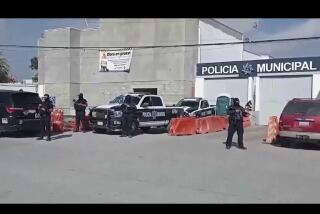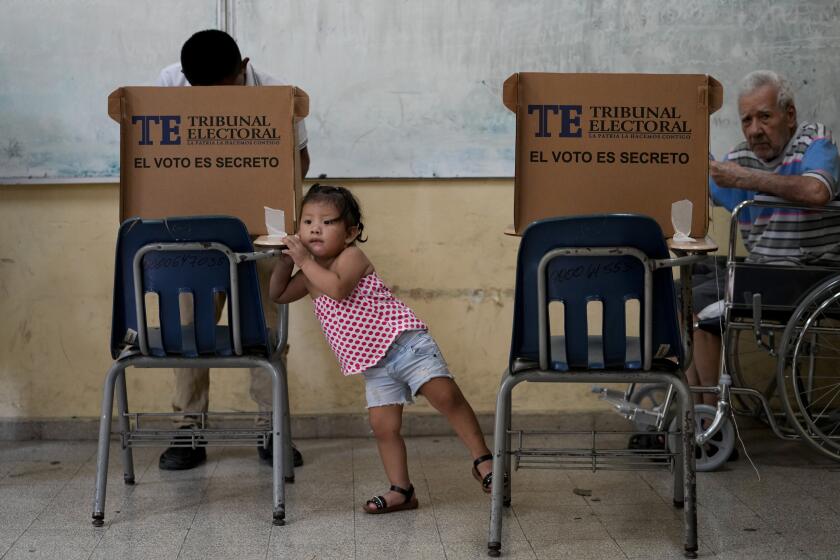Philanthropy That Was Deeply Personal
Long before her death, Joan Kroc had begun building her legacy.
In the mid-1990s, her representatives approached the Salvation Army with an idea for erecting a community center in a rundown neighborhood here. Officials from the group penciled out several rough budgets.
Kroc, who died in October at age 75, rejected them all.
“Think big,” she exhorted, “bigger than you’ve ever thought before.”
Two weeks ago, the world discovered just how big Kroc had been thinking. Her estate announced a bequest of more than $1.5 billion to the Salvation Army -- one of the largest charitable gifts in the nation’s history -- to build 25 to 30 community centers across the United States in hopes of transforming blighted neighborhoods.
The huge gift grew out of a long process in which Kroc tested the army, seeing whether the 130-year-old organization could expand its vision to match hers.
“She wanted to ensure that we could address the needs of the whole person, way beyond Christmas kettles and thrift stores,” said Maj. Cindy Foley, now the co-administrator of the Ray and Joan Kroc Corps Community Center in San Diego’s Rolando neighborhood.
What had attracted Kroc to the Salvation Army, friends and close associates say, was its sturdy reputation as a cost-effective organization with a soft spot for needy kids, a nationwide reach and low overhead.
The group had been a favorite of her late husband, Ray Kroc, the billionaire magnate of McDonald’s, who had donated freely and worked as a bell-ringer next to the ubiquitous red kettles during Christmas fundraising drives. The charity would be a good steward of her money, she believed.
But officials of the somewhat dowdy organization, whose public image seems stuck in the “Major Barbara” era, were slow to let their imaginations loose. It wasn’t easy to prod an institution used to gathering donations from spare change to conceive of a willing benefactor with a fortune of staggering size.
In the 19th and 20th centuries, many of the great philanthropic gifts grew out of vast industrial enterprises: Rockefeller and oil, Ford and automobiles, Andrew Carnegie, who built the U.S. steel industry and dreamed of putting a public library in every town in America.
Kroc’s fortune stemmed from the service economy -- billions of dollars in sales of fast food. Her goal was using that wealth to create places for children to flourish and to build communities out of fractured neighborhoods.
When Kroc first approached the Salvation Army, its officials did not know -- nobody outside Kroc’s tight circle of confidants did -- that the Rolando center was a prototype.
“I remember her saying, ‘San Diego is the pilot project. If it works here, Maureen, we are going to do it everywhere,’ ” said former Mayor Maureen O’Connor.
The idea began with a drive through one of the city’s poorer neighborhoods. O’Connor wanted her wealthy friend to see how the rest of the country lived. Their guide and driver was Police Sgt. Mike O’Neill, a veteran beat cop.
“I won’t say Mrs. Kroc was isolated, but she really didn’t know much about places where people have garage sales on their lawns every day and kids don’t have places to go,” he said.
Cruising in O’Neill’s Ford Aerostar, the trio stopped to talk to people on street corners. Kroc learned that the kinds of opportunities taken for granted in affluent neighborhoods were sparse or sometimes nonexistent elsewhere.
“I remember her saying, ‘I’ve got to do something about this,’ ” O’Neill recalled. “I couldn’t tell what she was going to do. But I could tell from the tone of her voice it was going to be big.”
Joan and Ray Kroc had married in 1969 after her divorce from her first husband, a McDonald’s franchisee. Ray, a hard-driving, cantankerous entrepreneur, had met her in 1957 while she was playing the piano in a nightclub; he was immediately smitten with her friendly, fun-loving manner.
When he died in 1984 at the age of 82, his widow was thrust into the spotlight, inheriting his baseball team -- the San Diego Padres. She tired of the bickering of professional sports and sold the team in 1990, but she never abandoned her husband’s belief in philanthropy.
He had formalized his giving with a foundation. She preferred a personal touch, guided by an informal protocol.
“You never asked; you just waited until it was your time,” said Blair T. Blum, vice president of the San Diego Hospice. “She never forgot anything you told her.” Kroc donated $18.5 million to build the hospice, and her estate provided $20 million more after her death.
Kroc did not enjoy reducing people to supplicants.
“She wasn’t one of those rich people who love the ‘beg me, beg me, beg me,’ ” said Ian Campbell, general manager of the critically acclaimed San Diego Opera, which received $10 million from Kroc’s will. Gently, she demanded excellence, and hang the cost.
“She wanted to see everything done to the best level: whether it’s how a building is built or how an opera company is run,” Campbell said. “It’s extraordinary that we once had someone like that in our community.”
At the same time, Kroc knew how to use the influence of her money. In the mid-1980s, the Roman Catholic Diocese of San Diego and Msgr. Joseph Carroll, an independent-minded priest, were engaged in a power struggle over control of a downtown center for the homeless that Carroll directed. Kroc wrote a check for $3 million, but stipulated that only Carroll could make decisions on how it could be spent.
“Joan knew how to get things done,” Carroll said.
Last spring the Salvation Army wouldn’t let the San Diego Gay Men’s Chorus use its 600-seat theater for a concert. Salvation Army officials objected to the chorus’ plans to have several performers in drag.
Hearing of the rebuff, Kroc quietly donated a Bosendorfer grand piano worth $105,000 to the chorus, one of several contributions to gay organizations and causes. She also called Maj. Foley about the issue, and friends say Kroc told her that the Salvation Army needed to be more accepting of homosexuals.
Foley said that she explained to Kroc that the organization did not feel drag was appropriate for a family-oriented facility and that Kroc made no complaint. A few months later, however, the Salvation Army signed a contract to let a lesbian singing group perform in the theater.
Kroc’s philanthropic interests were apparent at her last birthday party, Aug. 27, at her home in Rancho Santa Fe. She had been diagnosed in late June with inoperable brain cancer, but most of her guests did not know of her condition.
“She never wanted a fuss made over her,” said Dick Starmann, a close friend and former McDonald’s publicist. Nonetheless, there were gifts -- and toasts lavishing her with praise.
Joyce Neu, director of the Joan B. Kroc Institute for Peace and Justice at the University of San Diego, gave Kroc a coffee table book about Africa. Kroc had given to famine relief in Africa and was concerned about the cycle of strife and starvation that seems to bedevil the continent. She had donated money to establish the peace center at the university and a similar program at Notre Dame to allow them to reach abroad for scholars and students. After her death, each of the institutes received $50 million.
Kevin Klose, president of National Public Radio, had come from Washington for the gathering. He brought a small, lacquered box from his days as a foreign correspondent in Moscow for the Washington Post.
The two had met a year earlier, when Kroc invited Klose to her home to discuss the need for greater reporting from abroad.
“We’re going to do really great things together,” she told him at the end of the party.
It was not until after Kroc’s death that Klose discovered, to his surprise, that her will would provide more than $200 million to NPR -- the largest donation in the organization’s history. The birthday party, he realized, had been a gathering for people to whom Kroc was preparing to entrust her money.
“It was all very poignant,” said Stephanie Bergsma, associate general manager for development at the San Diego-based Public Broadcasting System station KPBS. “She looked so beautiful but so fragile. She wasn’t interested in talking about herself. She’d say, ‘How are you, honey? What’s new?’ I knew I was going to miss her a lot.”
If, in her final weeks, Kroc talked at all about dying, friends said, her only regret was that she would not get to watch her great-grandchildren grow up. She was confident that one was destined to be president and another would be U.S. attorney general.
Friends who spent time with her near the end say she was satisfied that she had found the right way to dispense her immense estate.
In the last weeks of her life, Kroc would occasionally be driven to the Rolando center. Sometimes she would just sit unannounced in her car and watch children enjoying the playing fields, swimming pools and outdoor art classes.
The budget for Kroc’s first community center had started at a modest $2 million. But at her urging, the size and cost of the project had grown.
There was one feature on which she had insisted -- an ice skating rink. Given the neighborhood’s demographics, that might seem an unlikely addition, particularly one built to the exacting standards of the National Hockey League to prevent frost and puddles.
But Kroc talked of the joy she had felt as a girl in Minneapolis when, after years of lessons, she had won a skating contest and qualified for the city finals.
“She said that contest was one of those moments when she realized there was a value to hard work,” Major Foley recalled. “She wanted kids to get that feeling.”
And so, when the Salvation Army announced the $92-million donation to build the center -- a gift that at the time was the largest donation in its history, the plans included a skating rink -- the only one among the Salvation Army’s 9,000 sites in the United States.
When the center opened in 2002, Kroc had been convinced to make one of her rare public appearances. The complex, she said that sunny day, was more than a place for games and classes; it was “a miniature peace-center” where children of different backgrounds could meet.
Just weeks after visiting the facility for the final time, to check on the placement of one of her last gifts -- a sculpture by artist Henry Moore -- Kroc died of brain cancer at home.
She had lived long enough to see the Rolando center flourish, with 400,000 people using its facilities in its first year and the Salvation Army rising to the challenge of raising operating funds.
With the center thriving, the neighborhood is slowly on the mend. Home values are inching upward. Businesses are returning to once-empty strip malls.
“Joan’s only disappointment,” O’Connor said, “was that she wouldn’t see the Starbucks open across the street.”
More to Read
Start your day right
Sign up for Essential California for news, features and recommendations from the L.A. Times and beyond in your inbox six days a week.
You may occasionally receive promotional content from the Los Angeles Times.






